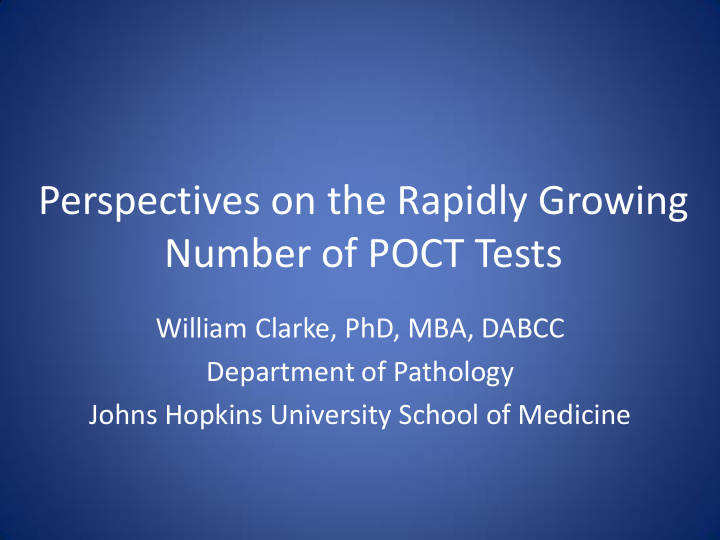



Perspectives on the Rapidly Growing Number of POCT Tests William Clarke, PhD, MBA, DABCC Department of Pathology Johns Hopkins University School of Medicine
Disclosures • Grant/Research Support: Thermo Fisher, Shimadzu, Nova Biomedical, Instrumentation Laboratories, miDiagnostics, NIH • Consultant/Advisory Board: Thermo Fisher, Shimadzu, Nova Biomedical, Roche Diagnostics, Instrumentation Laboratories, Radiometer, BD Diagnostics, Hitachi High-Technologies • Equity: miDiagnostics • Honorarium/Expenses: J&J • Intellectual Property/Royalty Income: None
Objectives • Describe the current POCT landscape – including existing technologies and emerging needs • Discuss challenges associated with the rapidly growing number of available POCT applications • Formulate strategies for efficiently managing a growing POCT program
In Vitro Diagnostics Market in $B POCT is strongest growing segment CAGR Point of Test 2013 2014 2015 2020 (2015- 2020) Laboratory 12.2 12.9 13.7 17.4 4.9% Hospitals 23.2 24.7 26.3 34.9 5.8% Academic Institutes 1.9 2.0 2.1 2.6 4.1% Point-of-Care 5.4 5.9 6.5 9.7 8.5% Patient Self-Testing 4.6 4.9 5.2 6.9 5.7% (Point-of-Need) Others (include blood banks, local public health laboratories, community clinics labs, home health 2.6 2.7 2.9 3.6 4.6% agencies, nursing homes, etc) Total 49.9 53.1 56.7 75.1 5.8% (Markets tsandMarkets, 20 2015)
Trends & Challenges Empowerment and Access • Care shifts from in- to outpatients • Patients and consumers are more health conscious • Emerging economies aim to improve health care • Increasing cost pressure within the health care systems Inefficiencies and negative impacts on patient outcome Context disruptions for health care professionals Delayed or false treatment Infrastructure gaps
Accountable Care Organizations http://modernpractices.com/2013/06/20/accountable-care-organizations-impact-on-behavioral-health-providers/
Home Health Testing
Disease Incidence & Prevalence (US) Prevalence (MM) Incidence (MM) 349 350 350 55 Incidence (MM) 25 50 Prevalence 46 20 40 31 30 15 30 27 23 10 20 17 11 4 9 10 5 6 4 0 0 Acute Pain Hemato. GI Pre- Neuro Immuno. Onc Uro. Musc/Skele. Resp. CVD** Chronic ID* Natal ID* Chronic Acute *Acute ID= bacterial + fungal infections; Chronic ID = HIV, Herpes, HCV, HBV ** = both acute and chronic indications included Sources. Cowen Report March 2010, NIH, CDC, NHLI, Wrongdiagnosis.com, emedicine.com, CMS CPT codes, NIAID, NCI
AdvaMedDx: Essentials of Diagnostics – Molecular Diagnostics (2013)
AdvaMedDx: Essentials of Diagnostics – Molecular Diagnostics (2013)
www.advameddx.org (innovation & value)
www.advameddx.org (innovation & value)
http://ho.seas.ucla.edu/group-members/postdoctoral-researchers/peter-lillehoj
http://dental.nyu.edu/faculty/biomaterials/mcdevitt-research-group.html
www.nanoporetech.com/technology/
NEAR-TERM EMERGING TECHNOLOGIES
CONSIDERATIONS FOR NEW TECHNOLOGIES
Accuracy of Laboratory Measurements • Accuracy = closeness of measurement to “truth” – Often standard reference is a substitute for “truth” • Inaccuracy is a function of 2 things: – Bias – Imprecision • There is no perfect analytical method
Perception vs. Reality
Pre-Analytical Factors • Poor technique in washing hands – Residual disinfectant – External contamination (e.g. juice) • Inappropriate sampling – Poor perfusion – Peripherial Vascular Disease – Shock/dehydration
How to address inaccuracy?
How to address inaccuracy? • Assumption of parameters/relationships • Active correction • Correction through device offsets • Standardization of Devices
Capillary Sampling
180 160 140 120 100 80 60 0 Hr 0.5 Hr 1 Hr 2 Hr 3 Hr Venous Capillary Davidson JK, Parker DR. Monitoring of blood and urine glucose and ketone levels. In Davidson JK, ed. Clinical Diabetes Mellitus Regittnig W, et al. Am J Physiol Endocrinol Metab 2003 (285) E241. Jungheim K, Koschinsky T. Diabetes Care 2001 (24) 1303.
Clinical Utility • POCT is not a “black box” fix; nor is it something to do just because it’s available • Does the POCT request fix the problem? – Will the test allow rule-in or rule-out diagnosis? – Why does the central or critical care/satellite lab not meet the need? – Can therapy or consultation be initiated based on POCT result?
Clinical Utility • Faster results does not guarantee improved clinical outcome • To assess clinical utility, need to evaluate: – Reason for ordering test – How the result will be utilized for patient care – Is POCT method appropriate for patient needs in that particular setting? • Communication with clinical staff is vital for determination of clinical utility and implementation
www.advameddx.org (innovation & value)
www.advameddx.org (innovation & value)
MANAGING AN INCREASING VARIETY OF TESTS
Joint Ownership of Program • Important for each of the clinical testing sites to have active involvement in program management – Self-education and inspection (QA) – Take responsibility for ongoing training and education • Schedule periodic joint leadership meetings – Allow communication of important points to users – Allow input from users for improved program efficiency
POCT Management at JHMI Nursing Medical POCT Standards of Director: Committee Care William Clarke Committee Manager: Jeanne Mumford POCT Coordinator: Serafina Brea (Bayview) QA Specialist: POCT Coordinator: POCT Coordinator: Lois Berk Ryan Work Gwendetta (Suburban) Norwood (Sibley) POCT Coordinator: POCT Coordinator: POCT Coordinator: POCT Coordinator: Sope Willoughby Leandra Soto Kitty Selitto (HCGH) Karen Reilly
Connected POC Network POC Devices Hospital or Department Patient Database LAN Central Data Manager
WHAT DO DATA-DRIVEN DECISIONS LOOK LIKE?
FDA Surveillance Grid
Hospital-Wide Analysis
Adult and Pediatric Emergency Dept
All JHH ICU’s
JHH MICU
Closing Thoughts • POCT has the potential to dramatically impact the delivery of healthcare – particularly outside of the hospital • Emerging technologies may significant increase the variety of testing platforms requested for POCT • With new technologies, there are many considerations for successful implementation • With increasing POCT, a thoughtful and efficient plan for management is crucial to a successful POCT program
QUESTIONS?? wclarke@jhmi.edu
Recommend
More recommend